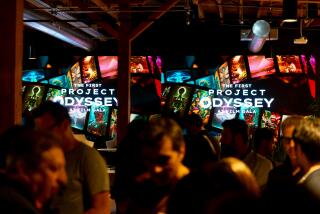MOVIE REVIEW : ‘Computer Animation’ Shows What the Genre Can, Can’t Do
“The Computer Animation Show,” a 90-minute compilation of short films (opening Wednesday at the Nuart Theater, in West Los Angeles, and Christmas Day at the Rialto Theater in Pasadena), is a glittering, upbeat program that showcases what computer animators can--and can’t--do.
The show surveys work done in the medium over the last five years, but the films aren’t presented in any order. No attempt is made to trace the development of computer graphics, and the result is a fast-paced, haphazard grab-bag of commercials, demo reels and test films, some as brief as 15 seconds. Network logos, motorcycles and beverage cans zoom in and out of infinity; plexiglass peacocks and neon letters dance through space; metallic dinosaurs and guitar players stalk through plastic landscapes.
Nothing in the theaters can match these films for sheer visual flash, but that doesn’t provide much conventional entertainment. The overall effect is a surfeit--the visual equivalent of eating five pounds of fudge at one sitting.
Individual images are often beautiful and sometimes dazzling, like the toy paperweights (each with a snowstorm inside) from Pacific Data Images’ “A Comic Zoom,” or the moving neon sculptures in Digital’s “Hard Woman” video for Mick Jagger.
But many of the films are devoid of content. The elaborate rooms in Elyse Vaintraub’s “Deja Vu” and the amusement park rides in Michael Scuilli’s “Fairplay” don’t communicate much to the viewer beside technical expertise. Great skill was obviously required to create Chris Wedge’s “Balloon Guy” and Toyo Link’s “Peppy,” but both films are ugly and pointless and hardly warrant the effort.
Some observers have inappropriately compared these films to “Steamboat Willie” (1927), the first Mickey Mouse cartoon. The animation in “Steamboat Willie” was technically crude, but its rowdy vitality captivated audiences. The viewers felt they knew the rambunctious little mouse who danced and played “Turkey in the Straw.”
The films in “The Computer Animation Show” represent the pinnacle of technical sophistication, but the vast majority of them are cold and uninvolving. Contrasts with other media underscore this fact. The fragile humanity of Bruce Schwartz’s rod puppet steals the shows from the sparkling animals in Bob Abel’s “Gold” commercial. A comparison between Abel’s computer-generated “Sexy Robot” and her human model only reveals how much subtler the woman’s movements are.
The viewer leaves the theater wondering what the future of computer animation will be. The flying chrome logos quickly cloy, and few--if any--of the attempts at traditional character animation can match the work being done by hand at Disney or Don Bluth or the better commercial studios.
As “The Computer Animation Show” amply demonstrates, computers can create wondrous effects. The question remains whether they can be used to tell stories that move audiences to laughter or tears, the way drawn animation has for more than 60 years.
More to Read
Only good movies
Get the Indie Focus newsletter, Mark Olsen's weekly guide to the world of cinema.
You may occasionally receive promotional content from the Los Angeles Times.










